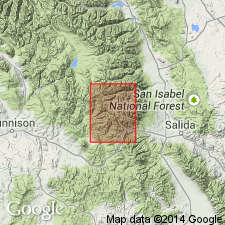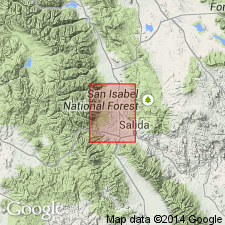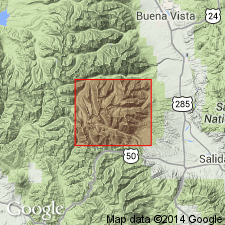
- Usage in publication:
-
- Mount Antero granite*
- Modifications:
-
- Named
- Dominant lithology:
-
- Granite
- AAPG geologic province:
-
- Eagle basin
Summary:
Named for occurrence on Mount Antero, its type locality, east of quad, Chaffee Co, CO in Eagle basin. Occurs as two stocks, several small outlying bodies, and dikes. Is light-gray to nearly white, medium-grained granite composed mostly of feldspar and quartz and a few grains of biotite. Contains a few scattered pink feldspar phenocrysts. The feldspars are orthoclase, microcline, and albite. Quartz occurs as single anhedral grains in clusters and microscopically intergrown with orthoclase. Is younger than Mount Pomeroy and Mount Princeton quartz monzonites. Assigned a Paleocene?, Eocene?, and Oligocene? age.
Source: GNU records (USGS DDS-6; Denver GNULEX).

- Usage in publication:
-
- Mount Antero Granite*
- Modifications:
-
- Age modified
- AAPG geologic province:
-
- Eagle basin
Summary:
Age changed from Paleocene? and Oligocene? to Oligocene. Mount Antero of Eagle basin is younger than Wall Mountain Tuff.
Source: GNU records (USGS DDS-6; Denver GNULEX).

- Usage in publication:
-
- Mount Antero Granite*
- Modifications:
-
- Overview
- AAPG geologic province:
-
- Piceance basin
- Eagle basin
Summary:
Mount Antero Granite is a texturally variable leucogranite exposed in two major areas at southeast corner of Mount Princeton batholith in Chaffee Co, CO in the Eagle basin and in Gunnison Co, CO in the Piceance basin. Differs from other rocks of the Mount Princeton in that it has no hornblende or euhedral sphene, and it does have muscovite and fluorite. Typical granite of Mount Antero considered coarse grained and is white to pink in hand specimen. Predominant minerals are pink potassium feldspar up to 1 cm long, rounded smoky quartz, and white plagioclase. Brown biotite occurs sporadically in books. Modal analyses. Geologic maps. Oligocene age.
Source: GNU records (USGS DDS-6; Denver GNULEX).
For more information, please contact Nancy Stamm, Geologic Names Committee Secretary.
Asterisk (*) indicates published by U.S. Geological Survey authors.
"No current usage" (†) implies that a name has been abandoned or has fallen into disuse. Former usage and, if known, replacement name given in parentheses ( ).
Slash (/) indicates name conflicts with nomenclatural guidelines (CSN, 1933; ACSN, 1961, 1970; NACSN, 1983, 2005, 2021). May be explained within brackets ([ ]).

